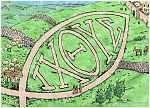Gospel Illustration: Communion - Bread & Wine
Click on Add to cart button below shopping cart.
Purchased Gospel Illustrations do not have watermarks. Links to Illustrations provided on email once purchase is completed.
Illustration code: 7000700101
Scene no: 1 of 1
Illustration Description
The Lord’s Supper (or the Last Supper) is recorded in the synoptic Gospels (Matthew, Mark & Luke) in these locations: Matthew 26:20-29, Mark 14:22-24, Luke 22:17-20.
Click the link below to see this Bible Cartoon in Matthew’s Gospel:
Bible Cartoon: Matthew 26 – The Lord’s Supper – scene 05 – Bread
Click the link below to see this Bible Cartoon in Mark’s Gospel:
Bible Cartoon: Mark 14 – The Lord’s Supper – Scene 06 – Bread
John’s gospel doesn’t record the event, but has Jesus teaching about Himself being the Bread of Life (see John 6:22-59)
Click the link below to see this Bible Cartoon:
Bible Cartoon: John 06 – Jesus, the bread of life
The Lord’s Supper is also referred to in 1 Corinthians 10:15-17, whilst in 1 Corinthians 10:21 Communion is referred to as “The cup of the Lord” & “The Lord’s table”.
1 Corinthians 11:23-26 also refers to The Lord’s Supper.
The early Christian church’s commitment to Communion can be seen in Acts 2:42.
DRAWING NOTES:
TIME OF DAY:
This cartoon has no particular time of day
LIGHTING NOTES:
The source of light in this scene is from an unseen torch or candle, which casts a yellow glow onto the items in the scene.
CHARACTERS PRESENT:
None.
RESEARCH/ADDITIONAL NOTES:
Communion (Greek. koinonia, “participation,” i.e., a festival in “common,” 1 Cor. 10:16) and Eucharist (“a giving of thanks”) because of the hymns and psalms that accompanied it. (Source: The New Unger’s Bible Dictionary.)
Communion is an important celebration of the sacrifice of Jesus the Christ upon the cross.
Matthew’s gospel presents Jesus’ own words about the significance of the bread & wine during the Lord’s Supper:
Matthew 26:26-28 (NLT)
As they were eating, Jesus took some bread and blessed it. Then he broke it in pieces and gave it to the disciples, saying, “Take this and eat it, for this is my body.” And he took a cup of wine and gave thanks to God for it. He gave it to them and said, “Each of you drink from it, for this is my blood, which confirms the covenant between God and his people. It is poured out as a sacrifice to forgive the sins of many.”
The breaking of the bread represents the breaking of the body of Jesus upon the cross, whilst the pouring of the wine; it’s deep red colour, can easily be seen as symbolic of the shed blood of the Lord upon the cross.
I drew this illustration in response to my own participation in communion, but also after receiving a request for it from a customer. I decided to make the bread unleavened (i.e. made without yeast) as Jesus was celebrating the Passover at this time. We know from Exodus 12:8 that God commanded the Hebrew people to eat bread made without yeast during the first Passover celebration & thereafter.
Exodus 12:8 (ANIV)
‘That same night they [the Hebrew people] are to eat the meat [lamb] roasted over the fire, along with bitter herbs, and bread made without yeast.’




